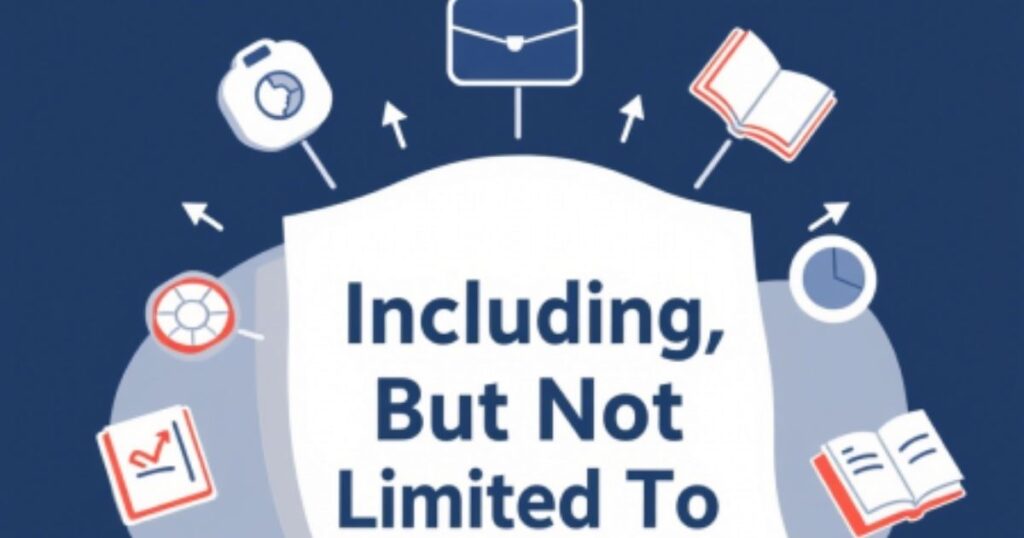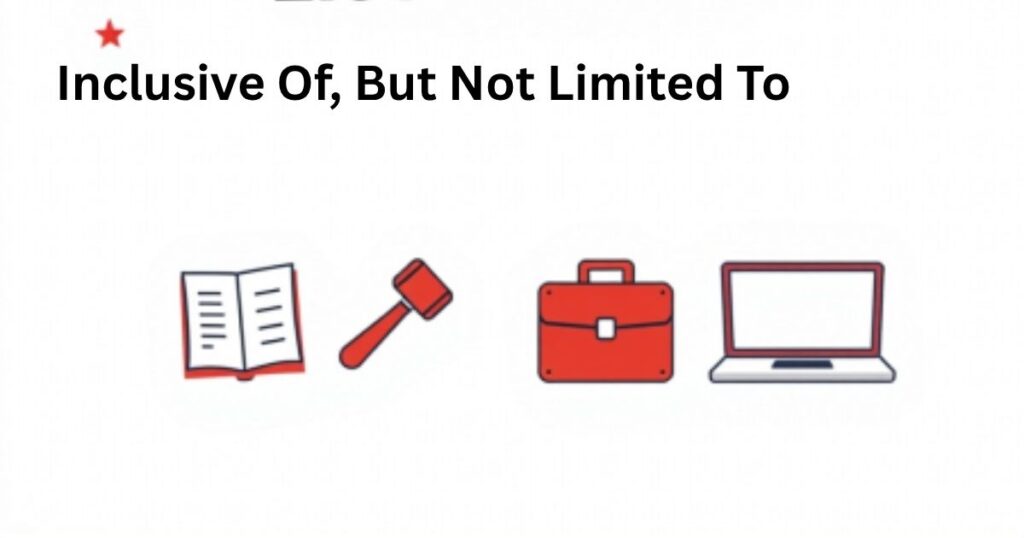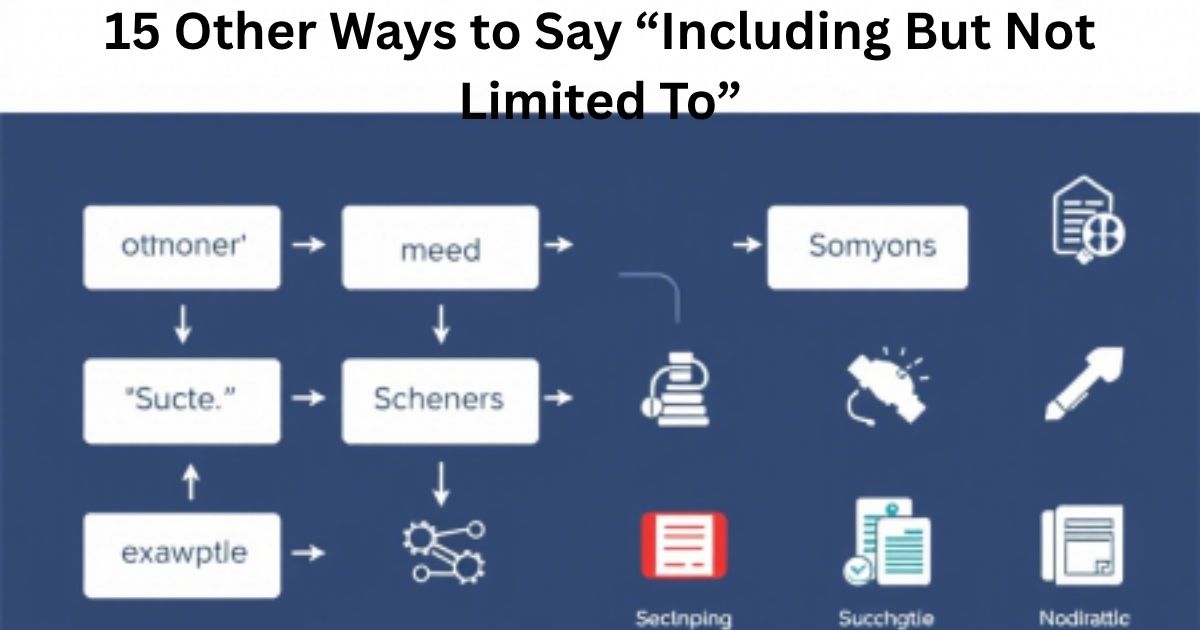In both formal and casual writing, we often list examples while making it clear that more items could be included. The phrase including but not limited to is commonly used for this purpose. It helps show that the list isn’t complete and other possibilities exist. Whether you’re writing emails, team reports, or legal documents, choosing the right phrasing makes your message clearer. Sometimes, repeating the same phrase can sound stiff or too formal, which is why writers and professionals look for an including but not limited to synonyms that suit different tones.
You might need a not limited to synonym that fits casual notes or a more refined option for workplace communication. If you’re searching for another word for including, this guide shares many useful choices. Each other way to say including but not limited to offers flexibility in language. Having a strong include but not limited to synonyms helps keep your writing both clear and professional.
Main Points
Writers often use “including but not limited to” to introduce examples or items while leaving the list open-ended. This phrasing is popular because it offers clarity and flexibility without sounding too definitive or closed. For instance, when you say something like, “Our team-building activities include, but are not limited to, a scavenger hunt and a picnic in the park,” it implies there are more items, but these are just a few you’re highlighting.
But repetition can hurt your style. When every message you send sounds the same, your writing loses its engaging edge. That’s where alternative expressions come in. By exploring various word choices, such as “such as,” “some options are,” or “with examples such as,” you can make your writing sound more conversational, polite, or professional, depending on your audience. Plus, swapping in synonyms and altering sentence structure improves your writing’s semantics, grammar, and overall tone.
- Say things in new ways
You don’t have to use the same words every time. Try saying it differently to keep your writing fresh. - Use short examples
Give just a few clear ideas. This helps people understand fast without reading a long list. - Make it friendly
Use soft and warm words. It makes people feel welcome and open to your message. - Keep your tone polite
Even in short messages, be respectful. Good words build better conversations at work and with friends. - Help your reader feel free
When you say “some ideas are,” it shows you are open to more. You’re not closing the door. - Use simple words
No need for big, hard words. Talk like you would in a normal, friendly chat. - Use everyday examples
Say things like “picnic, game, or meeting” so people can picture what you mean easily. - Don’t make big lists
Too many items can confuse people. Just share a few that give the idea. - Sound like a real person
Write the way you speak. People like it when it feels natural, not like a robot. - Keep it open and kind
Your words should feel open, not strict. Say things that let others add their own ideas too.
A Non-Exhaustive List Includes
This phrase sounds polished and is perfect when you need a more refined, professional tone. You’ll often see it in business reports, formal emails, or corporate correspondence. Saying “a non-exhaustive list includes” signals to your recipients that the list is open-ended but still thoughtfully composed. It’s ideal for use when communicating with superiors, clients, or key participants in professional settings.
It also works well in documents like training manuals or company strategy guides. For example, “A non-exhaustive list includes onboarding procedures, performance reviews, and team feedback sessions.” This structure emphasizes inclusivity and shows you’re not restricting possibilities while maintaining clarity and structure in your message.
Some Options Are
This one’s great for casual or friendly settings. It keeps the tone light and approachable, which is especially useful in group chats, emails to colleagues, or brainstorming sessions. When you’re making suggestions, like for team-building activities or meeting ideas, “some options are” feels more natural and engaging.
For instance, you might say, “Some options are a scavenger hunt, a picnic in the park, or a virtual escape room.” Notice how relaxed it feels. You’re not trying to sound overly formal , you’re just offering examples in a way that encourages conversation and flexibility. This expression is perfect for teams, peers, and friendly workplace communication.
Such As, But Not Limited To
This phrase strikes a nice balance between formality and flexibility. You’ll commonly find it in workplace emails, presentations, or reports where you want to sound professional but still welcoming. It allows you to give specific examples while keeping the list open-ended , a useful trick when discussing strategies, agenda items, or report highlights.
For instance, you could say, “Our team strategies include methods such as, but not limited to, goal tracking and feedback loops.” It feels structured without sounding robotic. The phrase also helps your audience stay focused while understanding the broader context of your message.
Including, But Not Limited To

This is the original phrase , widely used, legally sound, and well-understood. It’s commonly seen in contracts, HR documents, and policy manuals. It sounds formal and neutral, which is great when you need your message to be precise and legally clear. For example, in a workplace email: “Our benefits package includes, but is not limited to, health insurance, dental coverage, and a wellness stipend.”
Although it’s sometimes overused, it’s still suitable in situations where accuracy, structure, and a formal register are necessary. Still, to avoid sounding repetitive, you can rotate it with the other phrases in this article depending on your audience and tone.
Like, But Not Limited To
When you want to sound relatable and casual, this is your go-to phrase. It feels like something you’d say out loud in a meeting or friendly chat. If you’re writing a memo for a team event or talking to your readers informally, “like, but not limited to” does the job.
Try using it in messages like: “We’ll be using tools like, but not limited to, Slack, Zoom, and Google Docs.” It’s approachable and sets the right tone for casual settings, making it easier for your audience to engage with your message.
Find more words!
If you’re stuck using the same phrases repeatedly, it’s time to expand your vocabulary. Discovering more ways to say things improves your writing style, boosts readability, and enhances your communication across different contexts. For professional use, websites can help you find the right synonym, expression, or form to match your tone.
By diversifying your diction, you not only sound smarter, but you also create messages that stand out. Whether you’re writing to clients, coworkers, or your team, using new phrases gives your writing a more polished and thoughtful touch.
Comprising, But Not Limited To
This is a formal and precise phrase often seen in legal or structured business language. If you’re dealing with contracts, official policies, or professional documentation, “comprising, but not limited to” delivers clarity and shows a command of detailed writing.
For example: “The committee’s responsibilities are, but not limited to, budgeting, auditing, and financial reporting.” This style helps you sound well-informed, serious, and exact. However, it may come across as too rigid in casual communication, so save it for when you truly need structure and accuracy.
Inclusive Of, But Not Limited To

“Inclusive of, but not limited to” works well when you want to stress thoroughness while sounding polite and refined. It’s appropriate for professional emails, workplace documents, and communication with superiors. It suggests you’ve thought through your list but still want to leave room for more.
Use it like this: “Our onboarding program is inclusive of, but not limited to, job shadowing, orientation, and mentorship.” It’s a way to sound thoughtful and professional while still leaving things open-ended. This phrase fits perfectly into any structured business or HR communication.
With Examples Such As
Read this Also: 20 Synonyms for “Action Plan”
This phrase is friendly, clear, and perfect for explaining something to a general audience. Whether you’re creating training material, writing a presentation, or sending an internal email, “with examples such as” is great for readability. It doesn’t feel stuffy , just helpful.
Imagine saying: “Our recent projects, with examples such as the holiday campaign and brand refresh, highlight our creative strengths.” It gives your readers real illustrations, making your point more relatable and easier to understand. This is a great choice for writers looking to connect with teams, participants, or recipients in a way that feels inclusive and natural.
Comprised Of, But Not Limited To
Very similar to the earlier variation, “composed of, but not limited to” adds a formal touch, commonly found in academic or technical writing. It communicates precision while offering a wider range of possible items. You can use this in proposals, audits, or business reports.
For example: “The annual report consists of, but not limited to, quarterly reviews, financial summaries, and market forecasts.” This phrase helps you present your ideas with articulate and thorough structure, especially when writing to professionals or executives.
Containing, But Not Limited To
This expression offers a slightly softer alternative while still sounding correct and clear. It’s not as formal as “comprising,” but more polished than simply saying “like.” If you’re writing guides, internal documents, or process instructions, “containing, but not limited to” provides flexibility and keeps your tone consistent.
For instance, “This toolkit contains, but is not limited to, templates, checklists, and branding assets.” It makes your message feel well-rounded and professional without sounding too rigid. This is ideal for writers, managers, or senders of content that must walk the line between professional and relaxed.
Say It in a Different Way
In your everyday writing, you don’t always need to say the same phrase like “including but not limited to.” You can change it up. This keeps your emails, reports, and messages fresh and easy to read. Try using soft, kind expressions. Your audience will understand your point without feeling overwhelmed.
When writing to clients, teams, or colleagues, using variety makes your language feel warm and human. You can write, “We offer many services. Say it in a different way and mention a few, like web design, content writing, and social media help.” This keeps the message open and flexible without listing every option.
Give a Few Names
This phrase helps when you’re sharing examples. You don’t need to write everything. Just give a few names to make your idea clear. This works well in team chats, documents, and even short messages to your group. It keeps the tone light but clear.
For example, when planning a team-building event, you can say, “Give a few names: a picnic, a fun game, or a short trip.” You’re not saying these are the only options. You’re showing ideas while staying open to more. This helps everyone feel included in the plan.
A Small Set Might Be
When you want to offer some choices, this phrase is very helpful. It’s soft, friendly, and clear. You can say, “A small set might be morning meetings, open chats, or quick surveys.” This gives people room to think of more options. It also sounds polite and gentle.
This phrase is great in professional communication, like when writing to your superiors or recipients of a project email. You show that you’re offering help, not limiting their ideas. It keeps your tone professional but open-minded, which people in the workplace appreciate.
Names Can Be Like
“Names can be like” is useful when you need to share a list but don’t want to make it sound final. It’s great for presentations, memos, or even agendas. You can say, “Names can be like planning tools, note apps, and message boards.” This keeps your writing simple and smooth.
When talking to participants in a project or peers in a discussion, this kind of phrase makes your language more friendly. You’re not forcing a list , you’re giving a few helpful points. This way, others can add their thoughts easily without feeling boxed in.
We Could List Things Like

This phrase is good when explaining ideas to a team, writing to readers, or making a clear point in your work. It shows you’re not listing everything, just a few helpful items. For example, “We could list things like daily check-ins, shared calendars, and clear goals.” It shows options without closing the door on others.
Use this when you’re writing to clients, coworkers, or even writers on your team. It makes your writing more inclusive and gentle. Instead of sounding strict, you sound helpful and thoughtful. This works well in both formal emails and casual messages, keeping your communication balanced and polite.
FAQ’s
How to correctly write including but not limited to?
You should write including but not limited to before listing items. It means more things can be added, not just the ones you name.
What is a word for not limited to?
A good phrase like including but not limited to is among others or such as. These also show the list has more possible items.
How do you say including in a different way?
Instead of including but not limited to, try saying some options are, like, or for example to keep it easy and friendly.
What is the legal term including but not limited to?
In legal writing, including but not limited to means the list is not final. It protects you by allowing more things to be added.
Why do people say including but not limited to?
People use including but not limited to to be clear that the list they give is not complete. It’s useful in work, rules, or reports.
Conclusion
Using the phrase including but not limited to helps you show that your list has more items than just what you mention. It keeps things open and flexible. This is useful in writing emails, making reports, or sharing ideas at work. If you’re looking for an including but not limited to synonyms, try using words such as, among others, or with examples such as. These are easy and friendly ways to explain your ideas.
Sometimes you may want another word to include to keep your writing simple. You can say some options are or for example. If you need a not limited to synonym, try saying open to more or non-exhaustive. Looking for another way to say including but not limited to? Use phrases like like, but not limited to. These are all good include but not limited to synonym options. They help make your message clear and polite.

Gramcoachpro is your go-to platform for mastering grammar, writing, and communication skills. If you’re a student, teacher, or content creator, we provide easy-to-understand tips, examples, and tools to improve your language — fast and effectively. Our mission is to make better writing simple and accessible for everyone.

